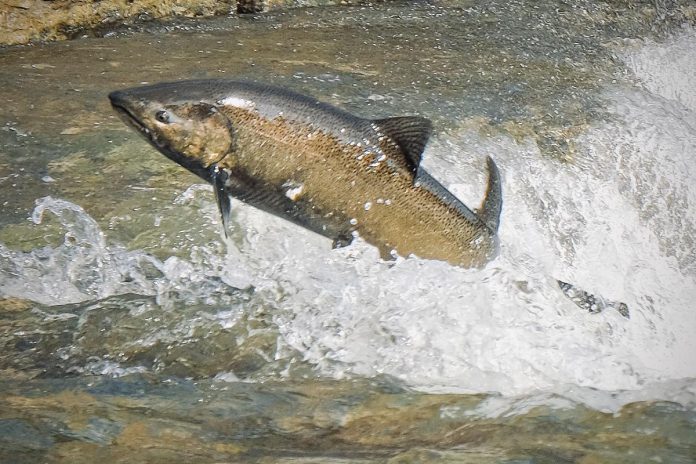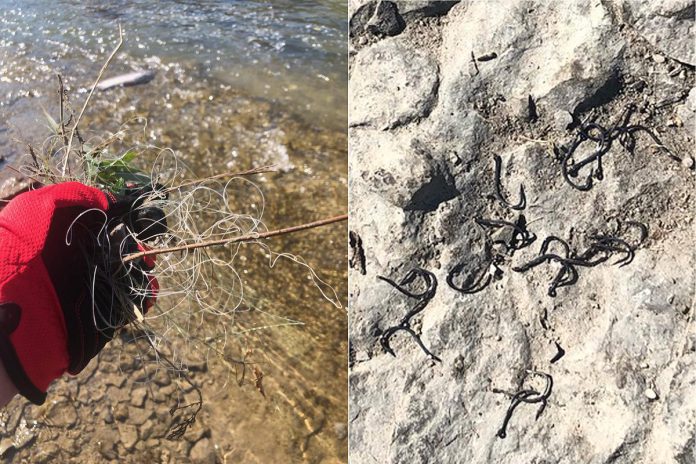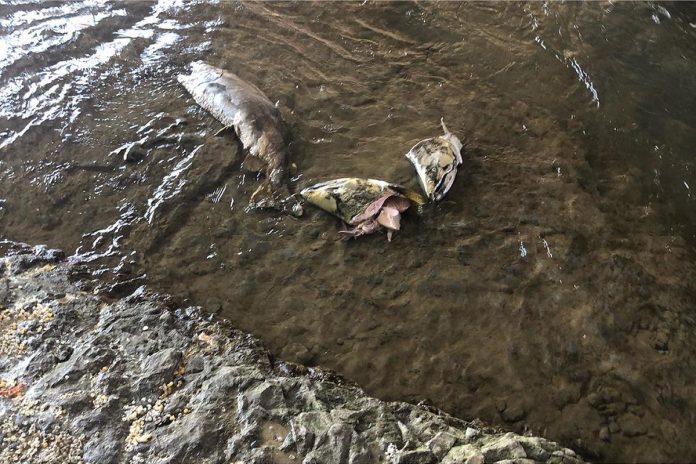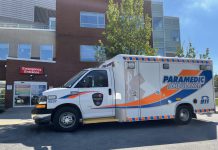
The Ontario government has approved new regulatory changes to protect to vulnerable salmon on the Ganaraska River in Port Hope during peak migration season, including through the creation of a new fish sanctuary. The changes take effect on Sunday (September 1).
Every fall, Port Hope sees an influx of both anglers and spectators during the annual salmon run, when tens of thousands of migrating Chinook salmon return to the Ganaraska River on their way to upstream spawning habitat — making it one of the largest salmon runs in Ontario.
The migrating salmon are slowed by the Corbett Dam fishway, which is located about three kilometres upstream from Lake Ontario. As it takes time for thousands of salmon to figure out how navigate the fishway, they accumulate in engineered step pools separated by shallow limestone stretches below the dam. This makes the fish highly visible and vulnerable to anglers.
“The Ganaraska River is a unique waterway because salmon migration is slowed down by the Corbett Dam fishway,” states a bulletin from the Ontario government released on Friday (August 30). “This creates a bottleneck of concentrated fish from Lake Ontario to the dam and leaves them little room to spread out or find cover.”
During the salmon run, some anglers have been catching the breeding salmon to harvest their roe (eggs) while discarding the rest of the fish. Others leave trash, fishing lines, and fishing hooks behind. Every fall following the salmon run, Port Hope residents have been cleaning up the waste.
Last fall, Port Hope resident Sean Carthew — who organizes the annual “Run Salmon Run” event for non-anglers who wish to celebrate the annual salmon migration — launched an online petition to urge changes to protect the salmon.

“The fishing and lack of respect for the river has gotten out of hand,” Carthew wrote. “It’s not safe to walk over thousands of hooks (not exaggerating). People have stopped coming to see the salmon / Port Hope because of the butchery. It’s affecting our image and tourism.”
“The salmon run should be a positive celebration and I’ve tried to do that with my Run Salmon Run celebration but I need your help! Imagine where we could go with this if we didn’t have a slaughterhouse in town!”
Carthew’s petition has garnered almost 14,000 signatures and came to the attention of the Municipality of Port Hope, which has been aware of the concerns during the salmon run but has not been able to directly address them as the provincial government had jurisdiction over fishing in Ontario.
According to a media release from Port Hope, the municipality has worked with the Ministry of Natural Resources (MNR), the Ontario Federation of Anglers and Hunters (OFAH), the Ganaraska Region Conservation Authority (GRCA), local authorities (including the Port Hope Police Service), and other stakeholders to address historical challenges during the fall salmon run.
In July, Port Hope council received a confidential briefing on the regulatory changes being considered by the MNR. As part of that confidential meeting, council directed Mayor Olga Hankivsky to engage with the ministry to seek support for addressing the specific impacts Port Hope may face during the fall, including requesting the implementation of a temporary variance order during the 2024 season.
The ministry approved the regulatory changes only a week after the end of the online consultation period, which took place from July 24 to August 22. Now approved, the regulatory changes mean portions of the Ganaraska River will be closed to fishing every year from September 1 through October 14 to provide protection for salmon as they move through the area.

Closures to fishing apply from the south side of the Jocelyn Street bridge to the CNR bridge, the first rail line north of Lake Ontario. The Ganaraska River is already closed to fishing all year from the 401 south to the Jocelyn Street bridge.
As part of the changes, the ministry is also extending the fishing season from October 15 through December 31 to allow anglers to catch a variety of trout and salmon species following the peak salmon migration season.
More details about the changes to Fisheries Management Zone (FMZ) 17 are available at ontario.ca/page/fisheries-management-zone-17-fmz-17.
With the new regulations taking effect on September 1, the Municipality of Port Hope is urging the public to exercise patience and understanding as some anglers will initially not be aware of the new rules.
“Authorities are committed to educating the community and ensuring that everyone is informed about the updated rules,” states a media release. “While enforcement measures will be in place, it is important to allow time for adjustments as the changes are implemented. The cooperation and consideration of all residents and visitors during this period will be greatly appreciated, contributing to a smoother and more effective adaptation to the new guidelines.”
As for Carthew’s annual “Run Salmon Run” celebration, the event is scheduled to take place from 11 a.m. to 3 p.m. on Sunday, September 8th at Rotary Park beside the Port Hope Library, along the river. The free event will feature fish ponds, live music, art, and education.


























